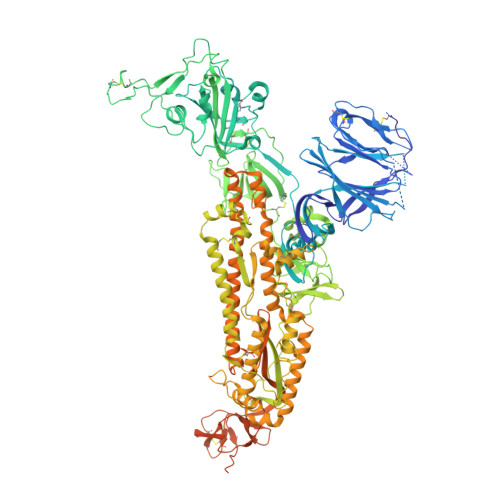A thermostable, closed SARS-CoV-2 spike protein trimer.
Xiong, X., Qu, K., Ciazynska, K.A., Hosmillo, M., Carter, A.P., Ebrahimi, S., Ke, Z., Scheres, S.H.W., Bergamaschi, L., Grice, G.L., Zhang, Y., Nathan, J.A., Baker, S., James, L.C., Baxendale, H.E., Goodfellow, I., Doffinger, R., Briggs, J.A.G.(2020) Nat Struct Mol Biol 27: 934-941
- PubMed: 32737467
- DOI: https://doi.org/10.1038/s41594-020-0478-5
- Primary Citation of Related Structures:
6ZOX, 6ZOY, 6ZOZ, 6ZP0, 6ZP1, 6ZP2 - PubMed Abstract:
The spike (S) protein of SARS-CoV-2 mediates receptor binding and cell entry and is the dominant target of the immune system. It exhibits substantial conformational flexibility. It transitions from closed to open conformations to expose its receptor-binding site and, subsequently, from prefusion to postfusion conformations to mediate fusion of viral and cellular membranes. S-protein derivatives are components of vaccine candidates and diagnostic assays, as well as tools for research into the biology and immunology of SARS-CoV-2. Here we have designed mutations in S that allow the production of thermostable, disulfide-bonded S-protein trimers that are trapped in the closed, prefusion state. Structures of the disulfide-stabilized and non-disulfide-stabilized proteins reveal distinct closed and locked conformations of the S trimer. We demonstrate that the designed, thermostable, closed S trimer can be used in serological assays. This protein has potential applications as a reagent for serology, virology and as an immunogen.
Organizational Affiliation:
Structural Studies Division, Medical Research Council Laboratory of Molecular Biology, Cambridge, UK. xiong@mrc-lmb.cam.ac.uk.

















